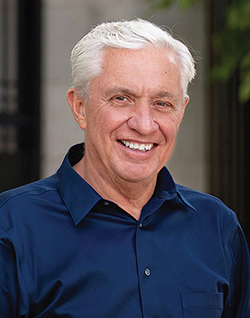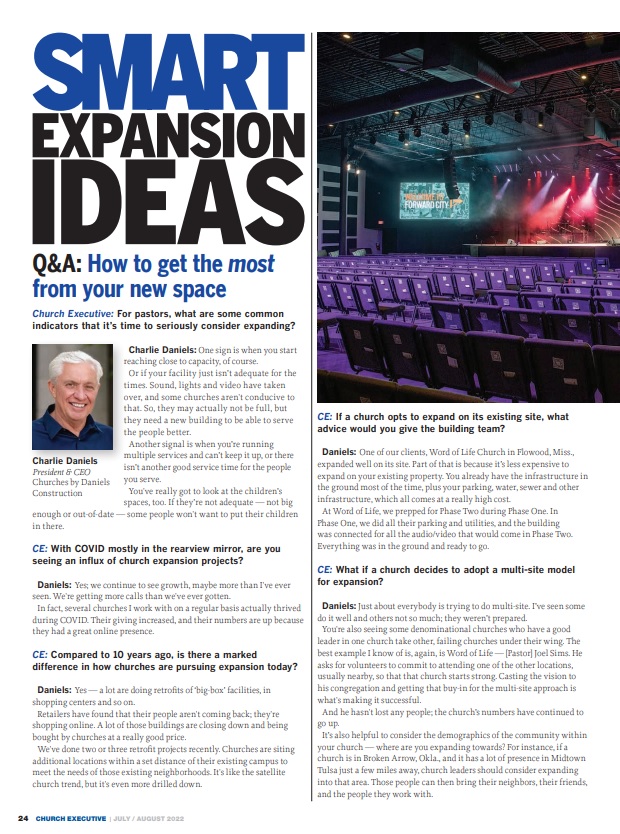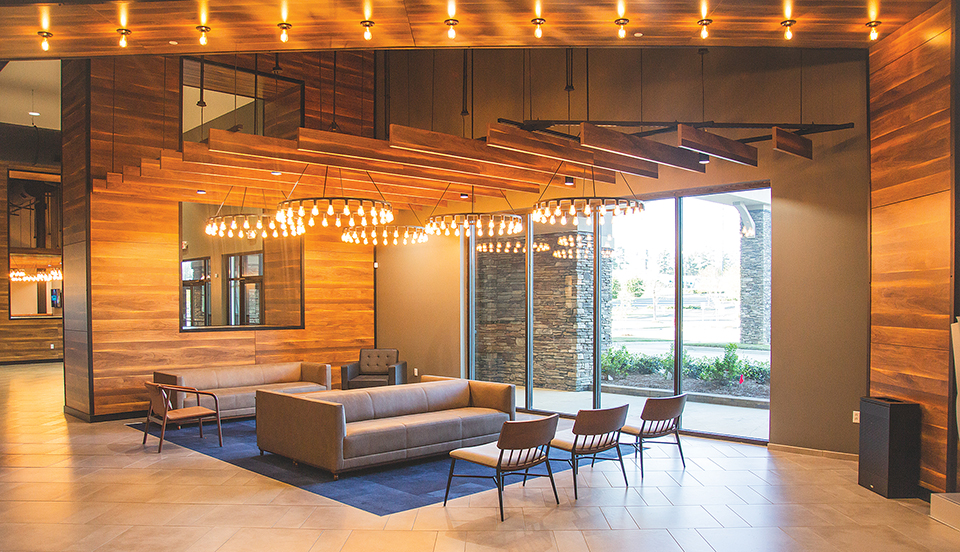
Q&A: How to get the most from your new space

President & CEO
Churches by Daniels Construction
Church Executive: For pastors, what are some common indicators that it’s time to seriously consider expanding?
Charlie Daniels: One sign is when you start reaching close to capacity, of course.
Or if your facility just isn’t adequate for the times. Sound, lights and video have taken over, and some churches aren’t conducive to that. So, they may actually not be full, but they need a new building to be able to serve the people better.
Another signal is when you’re running multiple services and can’t keep it up, or there isn’t another good service time for the people you serve.
You’ve really got to look at the children’s spaces, too. If they’re not adequate — not big enough or out-of-date — some people won’t want to put their children in there.
CE: With COVID mostly in the rearview mirror, are you seeing an influx of church expansion projects?
Daniels: Yes; we continue to see growth, maybe more than I’ve ever seen. We’re getting more calls than we’ve ever gotten.
In fact, several churches I work with on a regular basis actually thrived during COVID. Their giving increased, and their numbers are up because they had a great online presence.
CE: Compared to 10 years ago, is there a marked difference in how churches are pursuing expansion today?
Daniels: Yes — a lot are doing retrofits of ‘big-box’ facilities, in shopping centers and so on.
Retailers have found that their people aren’t coming back; they’re shopping online. A lot of those buildings are closing down and being bought by churches at a really good price.
We’ve done two or three retrofit projects recently. Churches are siting additional locations within a set distance of their existing campus to meet the needs of those existing neighborhoods. It’s like the satellite church trend, but it’s even more drilled down.

CE: If a church opts to expand on its existing site, what advice would you give the building team?
Daniels: One of our clients, Word of Life Church in Flowood, Miss., expanded well on its site. Part of that is because it’s less expensive to expand on your existing property. You already have the infrastructure in the ground most of the time, plus your parking, water, sewer and other infrastructure, which all comes at a really high cost.

At Word of Life, we prepped for Phase Two during Phase One. In Phase One, we did all their parking and utilities, and the building was connected for all the audio/video that would come in Phase Two. Everything was in the ground and ready to go.
CE: What if a church decides to adopt a multi-site model for expansion?
Daniels: Just about everybody is trying to do multi-site. I’ve seen some do it well and others not so much; they weren’t prepared.
You’re also seeing some denominational churches who have a good leader in one church take other, failing churches under their wing. The best example I know of is, again, is Word of Life — [Pastor] Joel Sims. He asks for volunteers to commit to attending one of the other locations, usually nearby, so that that church starts strong. Casting the vision to his congregation and getting that buy-in for the multi-site approach is what’s making it successful.
And he hasn’t lost any people; the church’s numbers have continued to go up.
It’s also helpful to consider the demographics of the community within your church — where are you expanding towards? For instance, if a church is in Broken Arrow, Okla., and it has a lot of presence in Midtown Tulsa just a few miles away, church leaders should consider expanding into that area. Those people can then bring their neighbors, their friends, and the people they work with.

CE: What types of ministry spaces offer the most “bang for the buck” when expanding?
Daniels: I think we’re in a visual generation. It’s best if you can build a church in such a way that parents see a playground of children’s ministry facility when they drive by at 60 miles per hour.
Sometimes you don’t really need to expand much, just reconfigure. Maybe add a glassed-in area for a coffee shop.
Doing so is physical expansion, but it’s also expanding the church’s vision. It conveys that your church is trying to expand what people see about you, what they know about you.
Wayfinding is another great tool. A lot of times, if a person feels comfortable navigating the facility, they’re more apt to come back. If it’s hard to get where they want to be, or they can’t find it at all, many won’t.
CE: If a church decides to repurpose an existing building for its expansion efforts, what critical elements should pastors be looking for?
Daniels: When I go to these buildings with pastors, I’m looking at several things.
First, the height of the roof. You want a lot of AV, which takes about 23 feet in the auditorium. That accommodates a stage and a big screen. And if we can get 35 feet, that’s even better.
Another thing I’m looking at is parking. Is there enough? In a lot of these stores, there is enough; or there is adjacent property where parking can be added.
I’m looking to make sure there are fire sprinklers.
How’s the zoning? As a church, are you going to be allowed to move into that building?
Is there any asbestos in the building?
How bad is the roof? Somebody can give you an old Best Buy, but you’re not saving any money if you need to spend $1 million replacing the roof.
But if the roof is good — and the air-conditioners are good — you’re a long way down the path.
CE: For churches on a budget, what expansion strategies do you suggest?
Daniels: Sit down and establish your vision for the expansion. Then, we can take that vision and modify it a little bit to fit your budget. I never want people to spend money they don’t have.
Second, I’d encourage church leaders to do all the master planning up front, and then take it to the City and get it permitted. Often, by the time you do that, you’ve spent a year. And master planning isn’t cheap, so — hopefully — you’ve raised some more money by then and are ready to start the project.
CE: Anything else on the topic of smart expansion that we haven’t talked about yet?
Daniels: We all want a brand-new, shiny wing for the children’s space, or the offices, or a new sanctuary — but what does that look like in a practical application? That’s where the ‘smart’ part of smart expansion comes in. We have to really hammer out those elements in the beginning, as we’re casting that vision, because nobody wants to sit in a sanctuary that’s not properly air-conditioned. Nobody wants to leave their child in a nursery wing that’s too warm or not heated enough.
Also be thinking about how expansion will affect your church services. How will it affect the flow of the congregation coming and going? You want to make sure it won’t affect the day-to-day operation of your facility.
Lastly, choose the right partner. No matter who you decide to go with, make sure you’ve done your due diligence.
— Reporting by RaeAnn Slaybaugh


